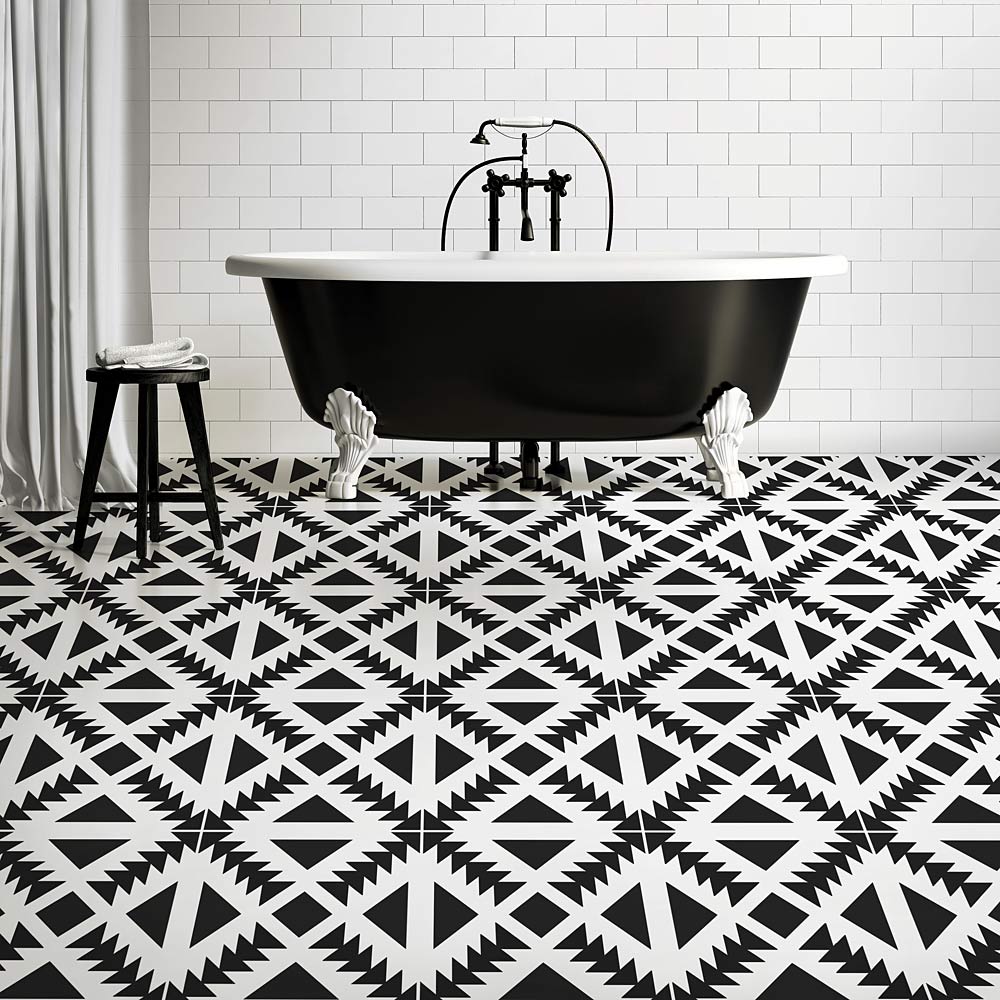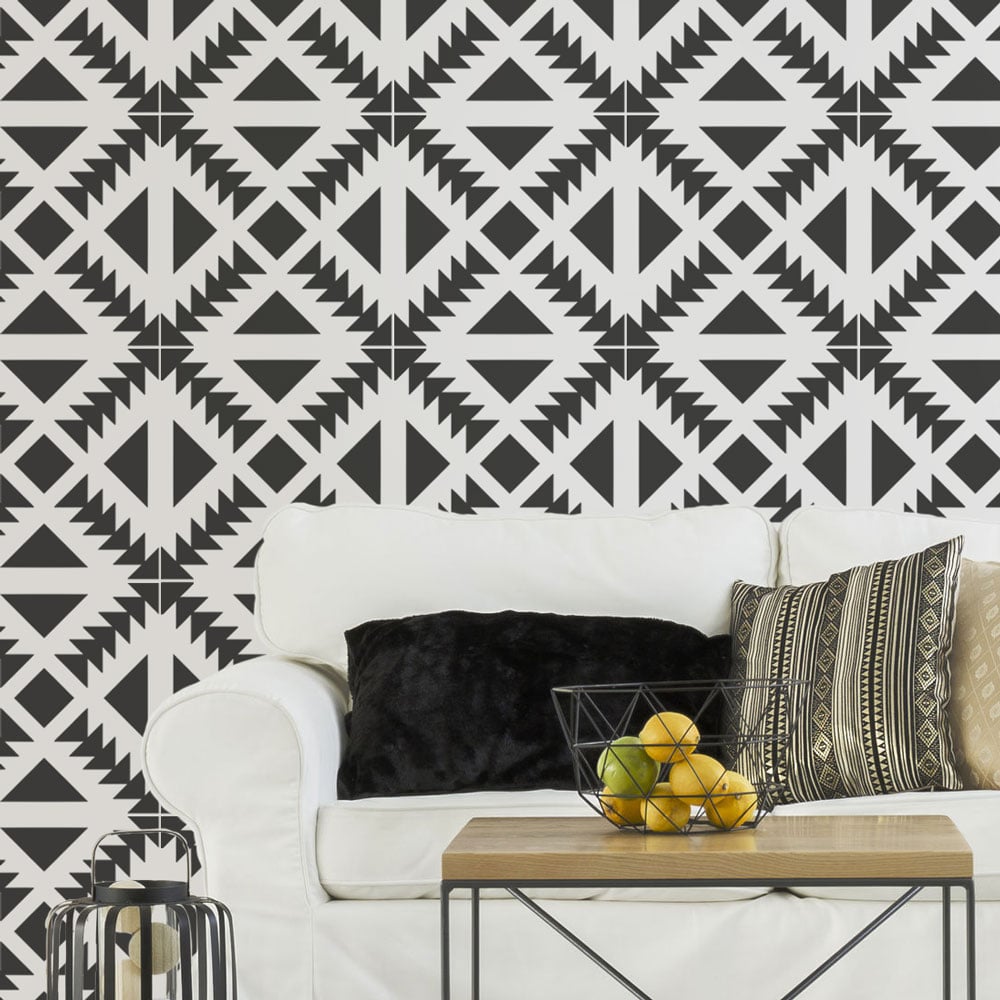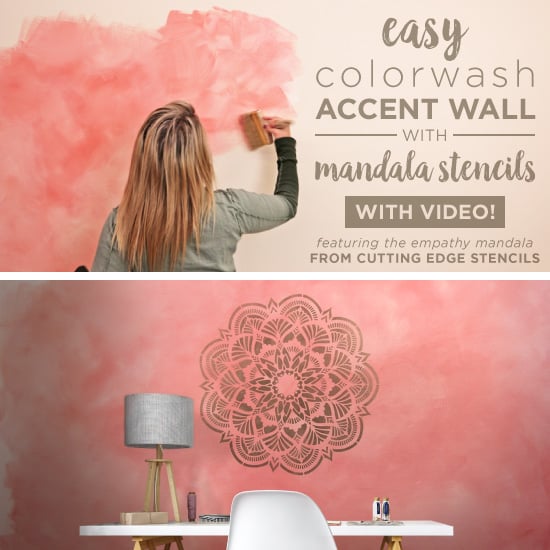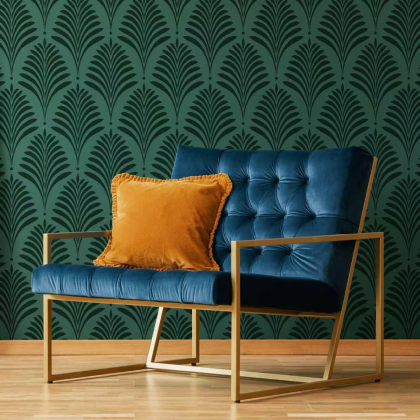Everything You Need to Stencil Your Tile Floors For Less
How To Stencil Tile Floors using Tile Stencil Patterns
To our
Cutting Edge Stencils fans, welcome back! We have the
biggest blog post of the year for you to bookmark or save on your computer! We will show you
EVERYTHING you need to stencil your tile floors for
LESS using
tile stencils. This step-by-step tutorial has every detail on floor preparation, stenciling technique, and top coat instructions to create the
perfect tile floor. This will make all of your
stencil projects so much
easier and by the end of this post, you'll be able to change your job title to "
Stencil Professional." First take a look at the complete "How-To" video tutorial and then follow along through each step with the written instructions. [DON'T FORGET TO ENTER THE GIVEAWAY AT THE END OF THIS POST] Let's begin
stenciling!

What You'll Need:
Step 1: Measuring Tiles
Before ordering your
Tile Stencil, you must measure your tile! The correct way to measure your tile is from tile edge to tile edge. You can use a ruler or measuring tape! Make sure you do
NOT include the grout lines. For this specific floor project, we want to ignore the grout lines. We decided this style will look best with this linoleum floor because the space between the ties is too thin. The size you measure will be the size you order!

[Pro Tip: We always recommend buying two stencils because it makes your project go by
WAY faster and easier.]
Step 2: Floor Preparation
Before your start painting, sand your tiles down using 220 grit sand paper. This gives your floor extra adhesion!

Then, rid your floors of any dust or dirt that may be left there. We recommend using TSP, a heavy-duty floor cleaner, when cleaning your floors before you stencil.

Tape the perimeter of your bathroom floor and toilet to avoid getting paint in unwanted areas.


After taping the baseboard, it is time to prime your floor! We recommend using STIX primer because we found it provides the best adhesion!

We are using a chip brush to paint the borders first, making sure we reach all the corners.

Then we are going to go in with a dense foam roller to cover the rest of the floor. You will want to apply about 2-3 coats of primer before the base coat. We
sand and prime the floor before stenciling because we want to make sure the paint
sticks to the tiles!


Once the primer is dry, we are going to paint our floor with the base coat color. [Pro Tip: You can save yourself a step and money by getting your primer tinted to the desired floor color at your local paint store!] For more information on what paint to use check out our
FAQ.

Otherwise, grab your paint color and apply 2-3 coats of your base color. Any interior matte or flat finished paint will work great! We recommend Benjamin Moore but Behr or Sherwin Williams will work great. For those asking about chalk paint, it is not required but you can use this as well!

Step 3: Stenciling Techniques
Apply spray adhesive to the back of your tile stencil. This is a key component to avoid any bleed that might occur underneath your stencil.

For this specific
floor project, we want to ignore the grout lines. We decided this style will look best with this linoleum floor because the space between the tiles is too thin. We are placing the stencil directly on the tile where the edges meet. Because we are not stenciling the grout lines, we covered the repeating registration marks with blue painters tape. [For more information on floor stenciling check out these
instructions.]


Another key factor when stenciling the perfect tile floor is all about how you load your dense foam roller. Evenly load the paint onto your roller and offload excess paint onto a paper towel.

Then with light pressure, apply paint onto the stencil! If there is too much paint on your
dense foam roller and you press down too hard, you will get some bleed! To accomplish a complete stencil you will need two coats of paint!


So far, so good!! Since we did not stencil the registration marks, we will align the stencil right next to the other so the corners touch. Now repeat this process on each full tile.


Our
Tile Stencils are super flexible and can bend to fit tricky corners. Just roll your paint as close as you can to the edge, and then go back with your
professional stencil brush and pounce where the floor meets the wall. Push down the stencil when pouncing in that area for crisp lines!

For those extra hard to reach places, this is where buying a second stencil comes in handy! Measure your partial tile and cut your stencil accordingly. Then place your stencil down and fill in those tiles. Don't be afraid to freehand any leftover space the stencil can't reach. To fix any bleed or smudges, our
Liner Brush is perfect for touchups.



Our
tiles are even flexible enough to fit around a curvy toilet. You can use a roller but we find that the best results when stenciling around the toilet are when you use a
professional stencil brush.

Step 4: Top Coat Instructions
Once you have finished stenciling and the floor is completely dry, it is time to
seal it with a
water-based polyurethane. It's important to use water-based because it is non-toxic, it has a rapid dry time, and it does NOT yellow over time. We recommend 2-3 coats of this! Please allow 2 hours of dry time between each coat and then you must wait a full 24 hours before you can start using your floors completely! For the future when cleaning your floors, you can go ahead and use any mop with soap and water just like usual. (Please stay away for any cleaners with alcohol!)


Take a look at how absolutely incredible the final product has turned out! We took this bathroom floor from drab to fab in such a short amount of time and for an insanely low price! Our stencil designs can change the look and feel of a room dramatically. What do you think? Check out this
stencil project Before & After below and enter the giveaway:
Before

After


Cutting Edge Stencils GIVEAWAY!
TWO WINNERS will be chosen to receive a $50 credit for the stencil of their choice! Participants must be from the US or Canada! Here are the rules to enter:
- Must follow us on Instagram @CuttingEdgeStencils
- Must comment below with your FAVORITE stencil in our collection.
-
Share this helpful post on Facebook or Pinterest!
The contest will run until 1/4/19 NOON EST and be announced on the winner's comment!
Can’t get enough of Cutting Edge Stencils:
Thanks for reading and happy stenciling!
Karli & The Cutting Edge Stencils Crew

 [Pro Tip: We always recommend buying two stencils because it makes your project go by WAY faster and easier.]
[Pro Tip: We always recommend buying two stencils because it makes your project go by WAY faster and easier.]
 Then, rid your floors of any dust or dirt that may be left there. We recommend using TSP, a heavy-duty floor cleaner, when cleaning your floors before you stencil.
Then, rid your floors of any dust or dirt that may be left there. We recommend using TSP, a heavy-duty floor cleaner, when cleaning your floors before you stencil.
 Tape the perimeter of your bathroom floor and toilet to avoid getting paint in unwanted areas.
Tape the perimeter of your bathroom floor and toilet to avoid getting paint in unwanted areas.

 After taping the baseboard, it is time to prime your floor! We recommend using STIX primer because we found it provides the best adhesion!
After taping the baseboard, it is time to prime your floor! We recommend using STIX primer because we found it provides the best adhesion!
 We are using a chip brush to paint the borders first, making sure we reach all the corners.
We are using a chip brush to paint the borders first, making sure we reach all the corners.
 Then we are going to go in with a dense foam roller to cover the rest of the floor. You will want to apply about 2-3 coats of primer before the base coat. We sand and prime the floor before stenciling because we want to make sure the paint sticks to the tiles!
Then we are going to go in with a dense foam roller to cover the rest of the floor. You will want to apply about 2-3 coats of primer before the base coat. We sand and prime the floor before stenciling because we want to make sure the paint sticks to the tiles!

 Once the primer is dry, we are going to paint our floor with the base coat color. [Pro Tip: You can save yourself a step and money by getting your primer tinted to the desired floor color at your local paint store!] For more information on what paint to use check out our FAQ.
Once the primer is dry, we are going to paint our floor with the base coat color. [Pro Tip: You can save yourself a step and money by getting your primer tinted to the desired floor color at your local paint store!] For more information on what paint to use check out our FAQ.
 Otherwise, grab your paint color and apply 2-3 coats of your base color. Any interior matte or flat finished paint will work great! We recommend Benjamin Moore but Behr or Sherwin Williams will work great. For those asking about chalk paint, it is not required but you can use this as well!
Otherwise, grab your paint color and apply 2-3 coats of your base color. Any interior matte or flat finished paint will work great! We recommend Benjamin Moore but Behr or Sherwin Williams will work great. For those asking about chalk paint, it is not required but you can use this as well!

 For this specific floor project, we want to ignore the grout lines. We decided this style will look best with this linoleum floor because the space between the tiles is too thin. We are placing the stencil directly on the tile where the edges meet. Because we are not stenciling the grout lines, we covered the repeating registration marks with blue painters tape. [For more information on floor stenciling check out these instructions.]
For this specific floor project, we want to ignore the grout lines. We decided this style will look best with this linoleum floor because the space between the tiles is too thin. We are placing the stencil directly on the tile where the edges meet. Because we are not stenciling the grout lines, we covered the repeating registration marks with blue painters tape. [For more information on floor stenciling check out these instructions.]

 Another key factor when stenciling the perfect tile floor is all about how you load your dense foam roller. Evenly load the paint onto your roller and offload excess paint onto a paper towel.
Another key factor when stenciling the perfect tile floor is all about how you load your dense foam roller. Evenly load the paint onto your roller and offload excess paint onto a paper towel.
 Then with light pressure, apply paint onto the stencil! If there is too much paint on your dense foam roller and you press down too hard, you will get some bleed! To accomplish a complete stencil you will need two coats of paint!
Then with light pressure, apply paint onto the stencil! If there is too much paint on your dense foam roller and you press down too hard, you will get some bleed! To accomplish a complete stencil you will need two coats of paint!

 So far, so good!! Since we did not stencil the registration marks, we will align the stencil right next to the other so the corners touch. Now repeat this process on each full tile.
So far, so good!! Since we did not stencil the registration marks, we will align the stencil right next to the other so the corners touch. Now repeat this process on each full tile.

 Our Tile Stencils are super flexible and can bend to fit tricky corners. Just roll your paint as close as you can to the edge, and then go back with your professional stencil brush and pounce where the floor meets the wall. Push down the stencil when pouncing in that area for crisp lines!
Our Tile Stencils are super flexible and can bend to fit tricky corners. Just roll your paint as close as you can to the edge, and then go back with your professional stencil brush and pounce where the floor meets the wall. Push down the stencil when pouncing in that area for crisp lines!
 For those extra hard to reach places, this is where buying a second stencil comes in handy! Measure your partial tile and cut your stencil accordingly. Then place your stencil down and fill in those tiles. Don't be afraid to freehand any leftover space the stencil can't reach. To fix any bleed or smudges, our Liner Brush is perfect for touchups.
For those extra hard to reach places, this is where buying a second stencil comes in handy! Measure your partial tile and cut your stencil accordingly. Then place your stencil down and fill in those tiles. Don't be afraid to freehand any leftover space the stencil can't reach. To fix any bleed or smudges, our Liner Brush is perfect for touchups.


 Our tiles are even flexible enough to fit around a curvy toilet. You can use a roller but we find that the best results when stenciling around the toilet are when you use a professional stencil brush.
Our tiles are even flexible enough to fit around a curvy toilet. You can use a roller but we find that the best results when stenciling around the toilet are when you use a professional stencil brush.


 Take a look at how absolutely incredible the final product has turned out! We took this bathroom floor from drab to fab in such a short amount of time and for an insanely low price! Our stencil designs can change the look and feel of a room dramatically. What do you think? Check out this stencil project Before & After below and enter the giveaway:
Take a look at how absolutely incredible the final product has turned out! We took this bathroom floor from drab to fab in such a short amount of time and for an insanely low price! Our stencil designs can change the look and feel of a room dramatically. What do you think? Check out this stencil project Before & After below and enter the giveaway:














